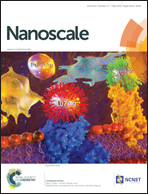Implications of orbital hybridization on the electronic properties of doped quantum dots: the case of Cu:CdSe†
Abstract
This paper investigates how chemical dopants affect the electronic properties of CdSe quantum dots (QDs) and why a model that incorporates the concepts of orbital hybridization must be used to understand these properties. Extended X-ray absorption fine structure spectroscopy measurements show that copper dopants in CdSe QDs occur primarily through a statistical doping mechanism. Ultraviolet photoemission spectroscopy (UPS) experiments provide a detailed insight on the valence band (VB) structure of doped and undoped QDs. Using UPS measurements, we are able to observe photoemission from the Cu d-levels above VB maximum of the QDs which allows a complete picture of the energy band landscape of these materials. This information provides insights into many of the physical properties of doped QDs, including the highly debated near-infrared photoluminescence in Cu doped CdSe QDs. We show that all our results point to a common theme of orbital hybridization in Cu doped CdSe QDs which leads to optically and electronically active states below the conduction band minimum. Our model is supported from current–voltage measurements of doped and undoped materials, which exhibit Schottky to Ohmic behavior with Cu doping, suggestive of a tuning of the lowest energy states near the Fermi level.


 Please wait while we load your content...
Please wait while we load your content...